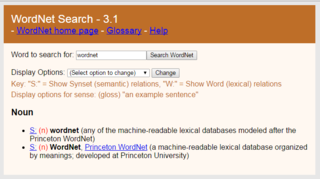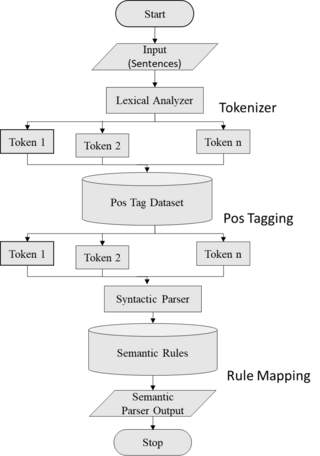Related Research Articles
Knowledge representation and reasoning is the field of artificial intelligence (AI) dedicated to representing information about the world in a form that a computer system can use to solve complex tasks such as diagnosing a medical condition or having a dialog in a natural language. Knowledge representation incorporates findings from psychology about how humans solve problems, and represent knowledge in order to design formalisms that will make complex systems easier to design and build. Knowledge representation and reasoning also incorporates findings from logic to automate various kinds of reasoning, such as the application of rules or the relations of sets and subsets.

Natural language processing (NLP) is an interdisciplinary subfield of computer science and linguistics. It is primarily concerned with giving computers the ability to support and manipulate human language. It involves processing natural language datasets, such as text corpora or speech corpora, using either rule-based or probabilistic machine learning approaches. The goal is a computer capable of "understanding" the contents of documents, including the contextual nuances of the language within them. The technology can then accurately extract information and insights contained in the documents as well as categorize and organize the documents themselves.

A semantic network, or frame network is a knowledge base that represents semantic relations between concepts in a network. This is often used as a form of knowledge representation. It is a directed or undirected graph consisting of vertices, which represent concepts, and edges, which represent semantic relations between concepts, mapping or connecting semantic fields. A semantic network may be instantiated as, for example, a graph database or a concept map. Typical standardized semantic networks are expressed as semantic triples.

WordNet is a lexical database of semantic relations between words that links words into semantic relations including synonyms, hyponyms, and meronyms. The synonyms are grouped into synsets with short definitions and usage examples. It can thus be seen as a combination and extension of a dictionary and thesaurus. While it is accessible to human users via a web browser, its primary use is in automatic text analysis and artificial intelligence applications. It was first created in the English language and the English WordNet database and software tools have been released under a BSD style license and are freely available for download from that WordNet website. There are now WordNets in more than 200 languages.
Natural-language understanding (NLU) or natural-language interpretation (NLI) is a subtopic of natural-language processing in artificial intelligence that deals with machine reading comprehension. Natural-language understanding is considered an AI-hard problem.
Open Mind Common Sense (OMCS) is an artificial intelligence project based at the Massachusetts Institute of Technology (MIT) Media Lab whose goal is to build and utilize a large commonsense knowledge base from the contributions of many thousands of people across the Web. It has been active from 1999 to 2016.
A modeling language is any artificial language that can be used to express data, information or knowledge or systems in a structure that is defined by a consistent set of rules. The rules are used for interpretation of the meaning of components in the structure Programing language.
Question answering (QA) is a computer science discipline within the fields of information retrieval and natural language processing (NLP) that is concerned with building systems that automatically answer questions that are posed by humans in a natural language.
Semantic similarity is a metric defined over a set of documents or terms, where the idea of distance between items is based on the likeness of their meaning or semantic content as opposed to lexicographical similarity. These are mathematical tools used to estimate the strength of the semantic relationship between units of language, concepts or instances, through a numerical description obtained according to the comparison of information supporting their meaning or describing their nature. The term semantic similarity is often confused with semantic relatedness. Semantic relatedness includes any relation between two terms, while semantic similarity only includes "is a" relations. For example, "car" is similar to "bus", but is also related to "road" and "driving".
Semantic AI is a privately held software company headquartered in San Diego, California with offices in the National Capitol Region. Semantic AI is a Delaware C-corporation that offers patented, graph-based knowledge discovery, analysis and visualization software technology. Its original product is a link analysis software application called Semantica Pro, and it introduced a web-based analytical environment called the Cortex Enterprise Intelligence Platform, or Cortex EIP.
The semantic gap characterizes the difference between two descriptions of an object by different linguistic representations, for instance languages or symbols. According to Andreas M. Hein, the semantic gap can be defined as "the difference in meaning between constructs formed within different representation systems". In computer science, the concept is relevant whenever ordinary human activities, observations, and tasks are transferred into a computational representation.
FrameNet is a group of online lexical databases based upon the theory of meaning known as Frame semantics, developed by linguist Charles J. Fillmore. The project's fundamental notion is simple: most words' meanings may be best understood in terms of a semantic frame, which is a description of a certain kind of event, connection, or item and its actors.
The term conceptual model refers to any model that is formed after a conceptualization or generalization process. Conceptual models are often abstractions of things in the real world, whether physical or social. Semantic studies are relevant to various stages of concept formation. Semantics is fundamentally a study of concepts, the meaning that thinking beings give to various elements of their experience.
Sentiment analysis is the use of natural language processing, text analysis, computational linguistics, and biometrics to systematically identify, extract, quantify, and study affective states and subjective information. Sentiment analysis is widely applied to voice of the customer materials such as reviews and survey responses, online and social media, and healthcare materials for applications that range from marketing to customer service to clinical medicine. With the rise of deep language models, such as RoBERTa, also more difficult data domains can be analyzed, e.g., news texts where authors typically express their opinion/sentiment less explicitly.
Computational lexicology is a branch of computational linguistics, which is concerned with the use of computers in the study of lexicon. It has been more narrowly described by some scholars as the use of computers in the study of machine-readable dictionaries. It is distinguished from computational lexicography, which more properly would be the use of computers in the construction of dictionaries, though some researchers have used computational lexicography as synonymous.
William Aaron Woods, generally known as Bill Woods, is a researcher in natural language processing, continuous speech understanding, knowledge representation, and knowledge-based search technology. He is currently a Software Engineer at Google.
Knowledge extraction is the creation of knowledge from structured and unstructured sources. The resulting knowledge needs to be in a machine-readable and machine-interpretable format and must represent knowledge in a manner that facilitates inferencing. Although it is methodically similar to information extraction (NLP) and ETL, the main criterion is that the extraction result goes beyond the creation of structured information or the transformation into a relational schema. It requires either the reuse of existing formal knowledge or the generation of a schema based on the source data.
The following outline is provided as an overview of and topical guide to natural-language processing:
Drama annotation is the process of annotating the metadata of a drama. Given a drama expressed in some medium, the process of metadata annotation identifies what are the elements that characterize the drama and annotates such elements in some metadata format. For example, in the sentence "Laertes and Polonius warn Ophelia to stay away from Hamlet." from the text Hamlet, the word "Laertes", which refers to a drama element, namely a character, will be annotated as "Char", taken from some set of metadata. This article addresses the drama annotation projects, with the sets of metadata and annotations proposed in the scientific literature, based markup languages and ontologies.

Semantic parsing is the task of converting a natural language utterance to a logical form: a machine-understandable representation of its meaning. Semantic parsing can thus be understood as extracting the precise meaning of an utterance. Applications of semantic parsing include machine translation, question answering, ontology induction, automated reasoning, and code generation. The phrase was first used in the 1970s by Yorick Wilks as the basis for machine translation programs working with only semantic representations. Semantic parsing is one of the important tasks in computational linguistics and natural language processing.
References
- Hermann Helbig, Die semantische Struktur natürlicher Sprache - Wissensrepräsentation mit MultiNet. Springer, Heidelberg, 2001.
- Hermann Helbig. Knowledge Representation and the Semantics of Natural Language , (2006) Springer, Berlin
- Sven Hartrumpf, Hermann Helbig, Johannes Leveling, Rainer Osswald. An Architecture for Controlling Simple Language in Web Pages, eMinds: International Journal on Human-Computer Interaction, 1(2), 2006.
- Sven Hartrumpf, Hermann Helbig, Tim vor der Brück, Christian Eichhorn: SemDupl: Semantic-based Duplicate Identification (2011)